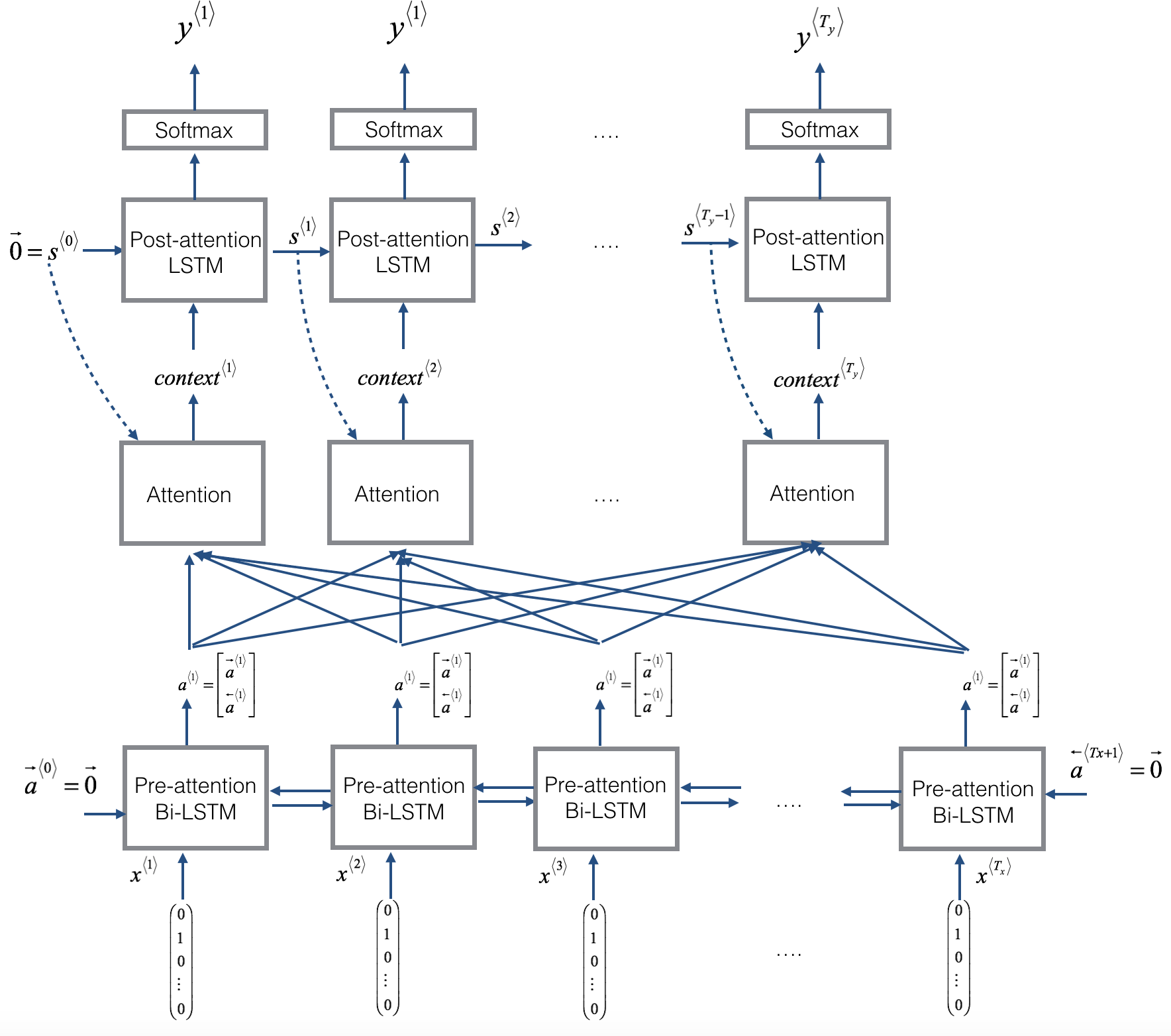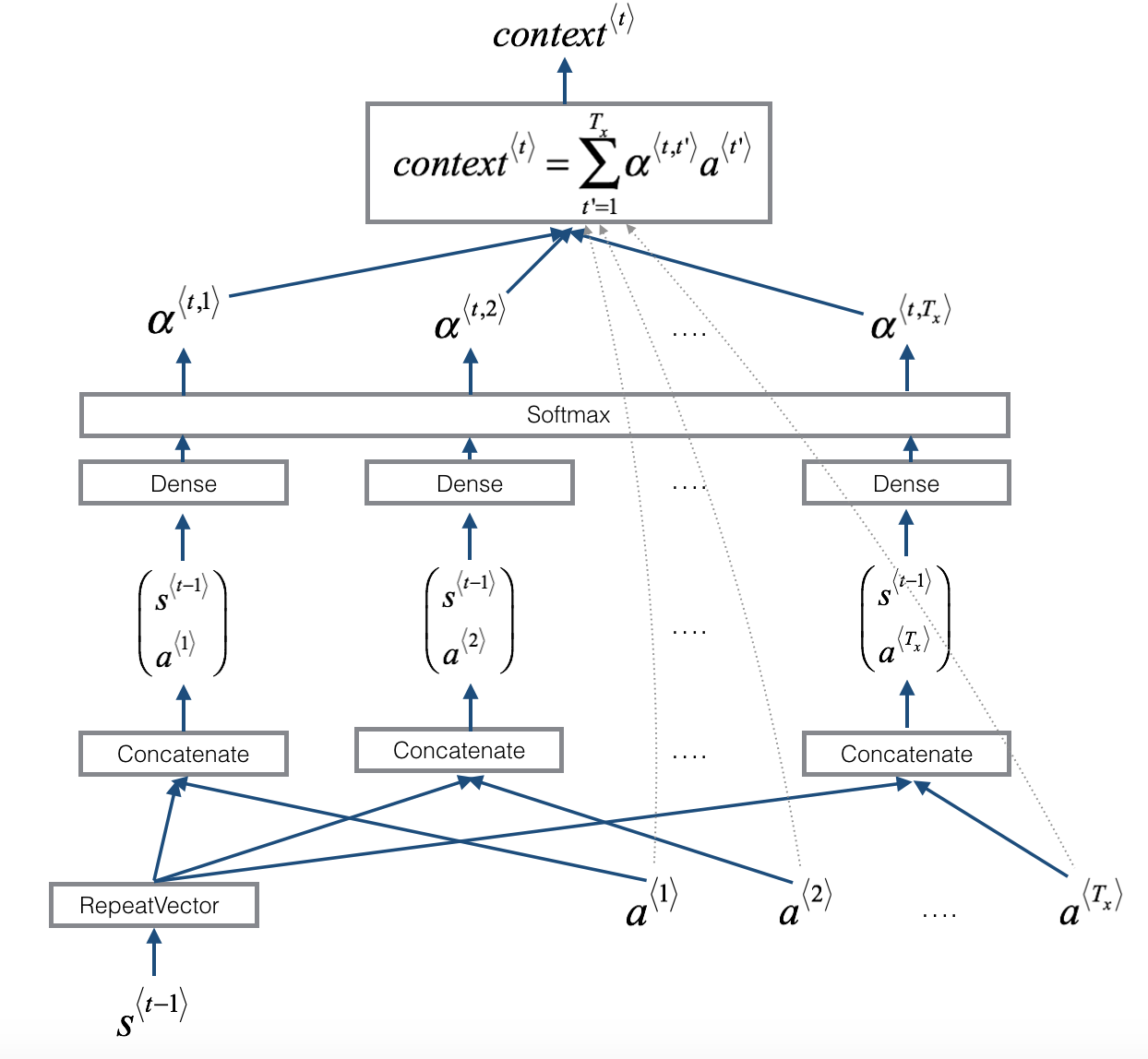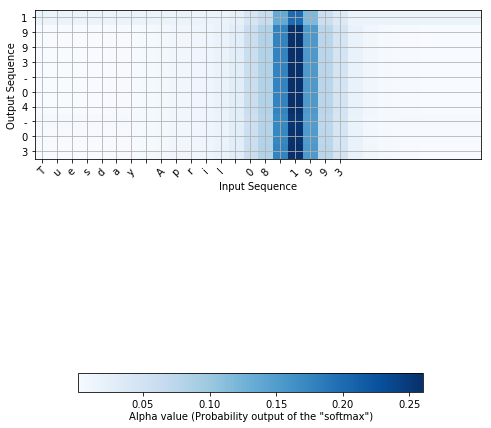本文将介绍注意力机制的基本原理,并通过Keras搭建一个神经网络机器翻译机以介绍注意力机制的实现过程,最后将其应用于日期格式翻译:从人类可读的日期(比如25th of June, 2009)翻译成机器可读的日期(2009-06-25)。该模型同样可以作为人类语言翻译的雏形。
1 | from keras.layers import Bidirectional, Concatenate, Permute, Dot, Input, LSTM, Multiply |
将人类可读的日期翻译为机器可读的日期
这里你所建立的模型也可以用来将一种语言翻译成另一种余元,比如将英语翻译成印第安语。但是,语言翻译需要大量的数据集,往往需要在多个GPU上训练好几天。为了不适用海量数据集就可以测试这些模型,我们选择更加简单的“日期翻译”任务。
这个网络将写成不同形式的日期(比如"the 29th of August 1958", "03/30/1968", "24 JUNE 1987")翻译成标准的机器可读的日期(比如"1958-08-29", "1968-03-30", "1987-06-24")。我们训练这个网络使得它学会输出机器可读的形式:YYYY-MM-DD。
数据集
我们在10000个人类可读的日期和对应的标准化机器可读的日期作为数据集。下面加载数据集,并显示几个例子。
1 | m = 10000 |
100%|██████████| 10000/10000 [00:01<00:00, 8664.72it/s]1 | dataset[:10] |
[('9 may 1998', '1998-05-09'),
('10.09.70', '1970-09-10'),
('4/28/90', '1990-04-28'),
('thursday january 26 1995', '1995-01-26'),
('monday march 7 1983', '1983-03-07'),
('sunday may 22 1988', '1988-05-22'),
('tuesday july 8 2008', '2008-07-08'),
('08 sep 1999', '1999-09-08'),
('1 jan 1981', '1981-01-01'),
('monday may 22 1995', '1995-05-22')]上面的命令下载了如下数据:
- dataset: 一系列元组(人类可读日期,机器可读日期)
- human_vocab: 人类可读日期中所使用的所有字符映射为整型索引的python字典
- machine_vocab: 机器可读日期中所使用的所有字符映射为整型索引的python字典
- inv_machine_vocab: machine_vocab的逆过程,从索引映射回字符
下面对数据进行预处理,并将纯文本数据映射到索引值。令Tx=30(假定人类可读的最大长度,如果更长,可以截断这个文本个),Ty=10(因为YYYY-MM-DD长度为10)。
1 | Tx = 30 |
X.shape: (10000, 30)
Y.shape: (10000, 10)
Xoh.shape: (10000, 30, 37)
Yoh.shape: (10000, 10, 11)现在你有:
- X: 训练集中预处理之后的人类可读日期,其中每个字符都通过human_vocab映射到对应的索引值。每个日期进一步用特殊字符(< pad >)补到Tx长。X.shape=(m,Tx)。
- Y: 训练集中预处理之后的机器可读日期,其中每个字符都通过machine_vocab映射到对应的索引值。Y.shape=(m,Ty)。
- Xoh: X的one-hot版本,采用human_vocab可以将元素为1的索引映射到对应的字符。Xoh.shape=(m, Tx, len(human_vocab))。
- Yoh: Y的one-hot版本,采用machine_vocab可以将元素为1的索引映射到对应的字符。Yoh.shape=(m, Tx, len(machine_vocab))。其中machine_vocab=11。
下面查看预处理之后的训练样本。
1 | index = 0 |
Source date: 9 may 1998
Target date: 1998-05-09
Source after preprocessing (indices): [12 0 24 13 34 0 4 12 12 11 36 36 36 36 36 36 36 36 36 36 36 36 36 36 36
36 36 36 36 36]
Target after preprocessing (indices): [ 2 10 10 9 0 1 6 0 1 10]
Source after preprocessing (one-hot): [[ 0. 0. 0. ..., 0. 0. 0.]
[ 1. 0. 0. ..., 0. 0. 0.]
[ 0. 0. 0. ..., 0. 0. 0.]
...,
[ 0. 0. 0. ..., 0. 0. 1.]
[ 0. 0. 0. ..., 0. 0. 1.]
[ 0. 0. 0. ..., 0. 0. 1.]]
Target after preprocessing (one-hot): [[ 0. 0. 1. 0. 0. 0. 0. 0. 0. 0. 0.]
[ 0. 0. 0. 0. 0. 0. 0. 0. 0. 0. 1.]
[ 0. 0. 0. 0. 0. 0. 0. 0. 0. 0. 1.]
[ 0. 0. 0. 0. 0. 0. 0. 0. 0. 1. 0.]
[ 1. 0. 0. 0. 0. 0. 0. 0. 0. 0. 0.]
[ 0. 1. 0. 0. 0. 0. 0. 0. 0. 0. 0.]
[ 0. 0. 0. 0. 0. 0. 1. 0. 0. 0. 0.]
[ 1. 0. 0. 0. 0. 0. 0. 0. 0. 0. 0.]
[ 0. 1. 0. 0. 0. 0. 0. 0. 0. 0. 0.]
[ 0. 0. 0. 0. 0. 0. 0. 0. 0. 0. 1.]]基于注意力机制的神经网络机器翻译系统
当你在将一段话从法语翻译成英语的过程中,你不会读完整段话,然后关上书本开始翻译。就算在翻译的过程中,你也是读了又读,然后聚焦在你要写下翻译对应的那部分法语部分。
注意力机制告诉神经网络翻译系统:每一步需要注意的部分
注意力机制
这部分将实现注意力机制。下图显示了这种机制的工作原理。
 |
 |
该模型具有以下特性:
- 左图的模型中有两个独立的LSTMs。下方的LSTM是双向的,且在注意力机制的前面,被称之为预注意力双向LSTM。上方的LSTM在注意力机制之后,被称为后注意力LSTM。预注意力双向LSTM通过\(T_x\)个时间步,后注意力LSTM通过\(T_y\)个时间步
- 后注意力LSTM将\(s^{<t>},c^{<t>}\)从一个时间步传到下一个时间步。但是,和语言生成模型不同的是后注意力LSTM在\(t\)时刻,并没有将之前生成的输出\(y^{<t-1>}\)作为输入。原因是在这个例子中,YYYY-MM-DD日期不像语言模型那样,相邻之间的字符串高度相关。
- 我们采用\(a^{\langle t \rangle} = [\overrightarrow{a}^{\langle t \rangle}; \overleftarrow{a}^{\langle t \rangle}]\)代表将预训练双向LSTM的正向和反向激励合并。
- 右图使用
RepeatVector节点将\(s^{\langle t-1 \rangle}\)的值拷贝了\(T_x\)次,然后用Concatenation合并\(s^{\langle t-1 \rangle}\)和\(a^{\langle t \rangle}\),计算\(e^{\langle t, t'}\)。然后传到softmax层计算\(\alpha^{\langle t, t' \rangle}\)。下面会使用Keras详细介绍如何使用RepeatVector和Concatenation。
1) one_step_attention(): 在时间\(t\),给定双向LSTM的所有隐藏层状态(\([a^{<1>},a^{<2>}, ..., a^{<T_x>}]\))和第二个LSTM层的隐藏状态(\(s^{<t-1>}\)),one_step_attention()将计算注意力函数(\([\alpha^{<t,1>},\alpha^{<t,2>}, ..., \alpha^{<t,T_x>}]\))和输出文本向量(如图右所示),\[context^{<t>} = \sum_{t' = 0}^{T_x} \alpha^{<t,t'>}a^{<t'>}\tag{1}\]。
注意:这里使用\(context^{\langle t \rangle}\)表示文本向量,而\(c^{\langle t \rangle}\)用来表示LSTM的内部记忆单元变量。
2) model(): 实现整个模型。首先运行双向LSTM得到\([a^{<1>},a^{<2>}, ..., a^{<T_x>}]\)。然后调用one_step_attention() \(T_y\) 次。每次计算内容向量\(c^{<t>}\)。将内容向量输入到第二个LSTM,经过带softmax激活函数的全连接层,得到预测值\(\hat{y}^{<t>}\)
注意:函数model()调用one_step_attention()\(T_y\)次,每次共享权函数。在Keras中实现共享权函数的层:
1. 定义层对象(比如作为全局变量)
2. 正传输入时调用这些对象
下面是需要用到的一些Keras函数以及帮助文档:
RepeatVector(), Concatenate(), Dense(), Activation(), Dot().
1 | # Defined shared layers as global variables |
使用上面提供的函数实现函数one_step_attention()。为了在其中一层正传一个Keras向量X,使用layer(X) (或在多个输入的情况下 layer([X,Y]))。
1 | # GRADED FUNCTION: one_step_attention |
下面实现函数model(),定义全局层以实现权值共享
1 | n_a = 64 |
下面调用这些层\(T_x\)次,生成输出,其中参数不会重新初始化。下面是详细步骤:
- 在双向LSTM中正传输入Bidirectional LSTM
- 循环\(t = 0, \dots, T_y-1\):
- 对 \([\alpha^{<t,1>},\alpha^{<t,2>}, ..., \alpha^{<t,T_x>}]\) 和 \(s^{<t-1>}\) 调用
one_step_attention()获得内容向量\(context^{<t>}\) .
- 给定 \(context^{<t>}\),输入到后注意力LSTM单元. 输入的是这个神经元的前一个隐藏状态 \(s^{\langle t-1\rangle}\) 和 单元状态\(c^{\langle t-1\rangle}\),输入组合成
initial_state= [previous hidden state, previous cell state]. 返回新的隐藏状态 \(s^{<t>}\) 和新的神经元状态 \(c^{<t>}\).
- 对\(s^{<t>}\)应用softmax层, 得到输出.
- 将输出添加到输出列表,保存输出.
- 对 \([\alpha^{<t,1>},\alpha^{<t,2>}, ..., \alpha^{<t,T_x>}]\) 和 \(s^{<t-1>}\) 调用
- 创建Keras模型实例,包含三个输入 ("输入", \(s^{<0>}\) 和 \(c^{<0>}\)) 和 输出一系列 "outputs".
1 | # GRADED FUNCTION: model |
创建模型
1 | model = model(Tx, Ty, n_a, n_s, len(human_vocab), len(machine_vocab)) |
WARNING:tensorflow:From /home/seisinv/anaconda3/envs/fwi_ai/lib/python3.5/site-packages/keras/backend/tensorflow_backend.py:1190: calling reduce_sum (from tensorflow.python.ops.math_ops) with keep_dims is deprecated and will be removed in a future version.
Instructions for updating:
keep_dims is deprecated, use keepdims instead
WARNING:tensorflow:From /home/seisinv/anaconda3/envs/fwi_ai/lib/python3.5/site-packages/keras/backend/tensorflow_backend.py:1154: calling reduce_max (from tensorflow.python.ops.math_ops) with keep_dims is deprecated and will be removed in a future version.
Instructions for updating:
keep_dims is deprecated, use keepdims instead1 | model.summary() |
____________________________________________________________________________________________________
Layer (type) Output Shape Param # Connected to
====================================================================================================
input_1 (InputLayer) (None, 30, 37) 0
____________________________________________________________________________________________________
s0 (InputLayer) (None, 128) 0
____________________________________________________________________________________________________
bidirectional_1 (Bidirectional) (None, 30, 128) 52224 input_1[0][0]
____________________________________________________________________________________________________
repeat_vector_1 (RepeatVector) (None, 30, 128) 0 s0[0][0]
lstm_1[0][0]
lstm_1[1][0]
lstm_1[2][0]
lstm_1[3][0]
lstm_1[4][0]
lstm_1[5][0]
lstm_1[6][0]
lstm_1[7][0]
lstm_1[8][0]
____________________________________________________________________________________________________
concatenate_1 (Concatenate) (None, 30, 256) 0 bidirectional_1[0][0]
repeat_vector_1[0][0]
bidirectional_1[0][0]
repeat_vector_1[1][0]
bidirectional_1[0][0]
repeat_vector_1[2][0]
bidirectional_1[0][0]
repeat_vector_1[3][0]
bidirectional_1[0][0]
repeat_vector_1[4][0]
bidirectional_1[0][0]
repeat_vector_1[5][0]
bidirectional_1[0][0]
repeat_vector_1[6][0]
bidirectional_1[0][0]
repeat_vector_1[7][0]
bidirectional_1[0][0]
repeat_vector_1[8][0]
bidirectional_1[0][0]
repeat_vector_1[9][0]
____________________________________________________________________________________________________
dense_1 (Dense) (None, 30, 1) 257 concatenate_1[0][0]
concatenate_1[1][0]
concatenate_1[2][0]
concatenate_1[3][0]
concatenate_1[4][0]
concatenate_1[5][0]
concatenate_1[6][0]
concatenate_1[7][0]
concatenate_1[8][0]
concatenate_1[9][0]
____________________________________________________________________________________________________
attention_weights (Activation) (None, 30, 1) 0 dense_1[0][0]
dense_1[1][0]
dense_1[2][0]
dense_1[3][0]
dense_1[4][0]
dense_1[5][0]
dense_1[6][0]
dense_1[7][0]
dense_1[8][0]
dense_1[9][0]
____________________________________________________________________________________________________
dot_1 (Dot) (None, 1, 128) 0 attention_weights[0][0]
bidirectional_1[0][0]
attention_weights[1][0]
bidirectional_1[0][0]
attention_weights[2][0]
bidirectional_1[0][0]
attention_weights[3][0]
bidirectional_1[0][0]
attention_weights[4][0]
bidirectional_1[0][0]
attention_weights[5][0]
bidirectional_1[0][0]
attention_weights[6][0]
bidirectional_1[0][0]
attention_weights[7][0]
bidirectional_1[0][0]
attention_weights[8][0]
bidirectional_1[0][0]
attention_weights[9][0]
bidirectional_1[0][0]
____________________________________________________________________________________________________
c0 (InputLayer) (None, 128) 0
____________________________________________________________________________________________________
lstm_1 (LSTM) [(None, 128), (None, 131584 dot_1[0][0]
s0[0][0]
c0[0][0]
dot_1[1][0]
lstm_1[0][0]
lstm_1[0][2]
dot_1[2][0]
lstm_1[1][0]
lstm_1[1][2]
dot_1[3][0]
lstm_1[2][0]
lstm_1[2][2]
dot_1[4][0]
lstm_1[3][0]
lstm_1[3][2]
dot_1[5][0]
lstm_1[4][0]
lstm_1[4][2]
dot_1[6][0]
lstm_1[5][0]
lstm_1[5][2]
dot_1[7][0]
lstm_1[6][0]
lstm_1[6][2]
dot_1[8][0]
lstm_1[7][0]
lstm_1[7][2]
dot_1[9][0]
lstm_1[8][0]
lstm_1[8][2]
____________________________________________________________________________________________________
dense_2 (Dense) (None, 11) 1419 lstm_1[0][0]
lstm_1[1][0]
lstm_1[2][0]
lstm_1[3][0]
lstm_1[4][0]
lstm_1[5][0]
lstm_1[6][0]
lstm_1[7][0]
lstm_1[8][0]
lstm_1[9][0]
====================================================================================================
Total params: 185,484
Trainable params: 185,484
Non-trainable params: 0
____________________________________________________________________________________________________预计的输出:
和之前一样,在Keras中创建好模型之后,需要编译并定义损失函数,优化器以及要使用的性能度量。使用categorical_crossentropy损失函数,自定义的优化器optimizer (learning rate = 0.005, \(\beta_1 = 0.9\), \(\beta_2 = 0.999\), decay = 0.01)和['accuracy']作为性能度量
1 | ### START CODE HERE ### (≈2 lines) |
WARNING:tensorflow:From /home/seisinv/anaconda3/envs/fwi_ai/lib/python3.5/site-packages/keras/backend/tensorflow_backend.py:1297: calling reduce_mean (from tensorflow.python.ops.math_ops) with keep_dims is deprecated and will be removed in a future version.
Instructions for updating:
keep_dims is deprecated, use keepdims instead最后一步:定义所有的输入和输出,并拟合模型。
- X的维度为\((m = 10000, T_x = 30)\) 包含所有的训练样本.
- 创建
s0和c0初始化post_activation_LSTM_cell为0. - 给定
model(), 输出 "outputs" 为 含11 个元素的序列,维度为 (m, T_y). 因此:outputs[i][0], ..., outputs[i][Ty]第\(i\) 个样本 (X[i])的真实标签(字符)(X[i]). 更一般的,outputs[i][j]为第\(i^{th}\)个训练样本第\(j^{th}\)个字符的真实标签。
1 | s0 = np.zeros((m, n_s)) |
下面拟合模型,只执行一次迭代。
1 | model.fit([Xoh, s0, c0], outputs, epochs=10, batch_size=100) |
Epoch 1/10
10000/10000 [==============================] - 33s - loss: 7.4147 - dense_2_loss_1: 0.1020 - dense_2_loss_2: 0.0813 - dense_2_loss_3: 0.6302 - dense_2_loss_4: 1.8963 - dense_2_loss_5: 0.0076 - dense_2_loss_6: 0.1562 - dense_2_loss_7: 1.6076 - dense_2_loss_8: 0.0046 - dense_2_loss_9: 0.9532 - dense_2_loss_10: 1.9758 - dense_2_acc_1: 0.9687 - dense_2_acc_2: 0.9723 - dense_2_acc_3: 0.7522 - dense_2_acc_4: 0.3075 - dense_2_acc_5: 0.9999 - dense_2_acc_6: 0.9523 - dense_2_acc_7: 0.4073 - dense_2_acc_8: 1.0000 - dense_2_acc_9: 0.5871 - dense_2_acc_10: 0.2662
Epoch 2/10
10000/10000 [==============================] - 33s - loss: 5.3461 - dense_2_loss_1: 0.0713 - dense_2_loss_2: 0.0602 - dense_2_loss_3: 0.4529 - dense_2_loss_4: 1.2917 - dense_2_loss_5: 0.0059 - dense_2_loss_6: 0.1070 - dense_2_loss_7: 1.2188 - dense_2_loss_8: 0.0054 - dense_2_loss_9: 0.7383 - dense_2_loss_10: 1.3946 - dense_2_acc_1: 0.9774 - dense_2_acc_2: 0.9792 - dense_2_acc_3: 0.8190 - dense_2_acc_4: 0.5389 - dense_2_acc_5: 0.9999 - dense_2_acc_6: 0.9695 - dense_2_acc_7: 0.5465 - dense_2_acc_8: 0.9998 - dense_2_acc_9: 0.6832 - dense_2_acc_10: 0.4885
Epoch 3/10
10000/10000 [==============================] - 33s - loss: 3.7412 - dense_2_loss_1: 0.0584 - dense_2_loss_2: 0.0498 - dense_2_loss_3: 0.3604 - dense_2_loss_4: 0.8144 - dense_2_loss_5: 0.0049 - dense_2_loss_6: 0.0930 - dense_2_loss_7: 0.9398 - dense_2_loss_8: 0.0045 - dense_2_loss_9: 0.5976 - dense_2_loss_10: 0.8183 - dense_2_acc_1: 0.9810 - dense_2_acc_2: 0.9819 - dense_2_acc_3: 0.8534 - dense_2_acc_4: 0.7320 - dense_2_acc_5: 1.0000 - dense_2_acc_6: 0.9734 - dense_2_acc_7: 0.6660 - dense_2_acc_8: 1.0000 - dense_2_acc_9: 0.7660 - dense_2_acc_10: 0.7118
Epoch 4/10
10000/10000 [==============================] - 33s - loss: 2.6837 - dense_2_loss_1: 0.0485 - dense_2_loss_2: 0.0414 - dense_2_loss_3: 0.2905 - dense_2_loss_4: 0.5242 - dense_2_loss_5: 0.0043 - dense_2_loss_6: 0.0762 - dense_2_loss_7: 0.6770 - dense_2_loss_8: 0.0042 - dense_2_loss_9: 0.4856 - dense_2_loss_10: 0.5319 - dense_2_acc_1: 0.9843 - dense_2_acc_2: 0.9844 - dense_2_acc_3: 0.8810 - dense_2_acc_4: 0.8535 - dense_2_acc_5: 1.0000 - dense_2_acc_6: 0.9779 - dense_2_acc_7: 0.7785 - dense_2_acc_8: 1.0000 - dense_2_acc_9: 0.8240 - dense_2_acc_10: 0.8149
Epoch 5/10
10000/10000 [==============================] - 34s - loss: 2.0444 - dense_2_loss_1: 0.0419 - dense_2_loss_2: 0.0348 - dense_2_loss_3: 0.2438 - dense_2_loss_4: 0.3605 - dense_2_loss_5: 0.0035 - dense_2_loss_6: 0.0624 - dense_2_loss_7: 0.4857 - dense_2_loss_8: 0.0038 - dense_2_loss_9: 0.4024 - dense_2_loss_10: 0.4056 - dense_2_acc_1: 0.9866 - dense_2_acc_2: 0.9865 - dense_2_acc_3: 0.8946 - dense_2_acc_4: 0.8977 - dense_2_acc_5: 1.0000 - dense_2_acc_6: 0.9815 - dense_2_acc_7: 0.8585 - dense_2_acc_8: 0.9998 - dense_2_acc_9: 0.8549 - dense_2_acc_10: 0.8575
Epoch 6/10
10000/10000 [==============================] - 34s - loss: 1.6617 - dense_2_loss_1: 0.0354 - dense_2_loss_2: 0.0283 - dense_2_loss_3: 0.2110 - dense_2_loss_4: 0.2748 - dense_2_loss_5: 0.0029 - dense_2_loss_6: 0.0569 - dense_2_loss_7: 0.3805 - dense_2_loss_8: 0.0030 - dense_2_loss_9: 0.3356 - dense_2_loss_10: 0.3333 - dense_2_acc_1: 0.9878 - dense_2_acc_2: 0.9891 - dense_2_acc_3: 0.9083 - dense_2_acc_4: 0.9206 - dense_2_acc_5: 1.0000 - dense_2_acc_6: 0.9843 - dense_2_acc_7: 0.8917 - dense_2_acc_8: 1.0000 - dense_2_acc_9: 0.8778 - dense_2_acc_10: 0.8811
Epoch 7/10
10000/10000 [==============================] - 34s - loss: 1.3926 - dense_2_loss_1: 0.0286 - dense_2_loss_2: 0.0225 - dense_2_loss_3: 0.1850 - dense_2_loss_4: 0.2215 - dense_2_loss_5: 0.0026 - dense_2_loss_6: 0.0493 - dense_2_loss_7: 0.3083 - dense_2_loss_8: 0.0026 - dense_2_loss_9: 0.2848 - dense_2_loss_10: 0.2876 - dense_2_acc_1: 0.9923 - dense_2_acc_2: 0.9916 - dense_2_acc_3: 0.9179 - dense_2_acc_4: 0.9288 - dense_2_acc_5: 1.0000 - dense_2_acc_6: 0.9848 - dense_2_acc_7: 0.9155 - dense_2_acc_8: 1.0000 - dense_2_acc_9: 0.8996 - dense_2_acc_10: 0.8946
Epoch 8/10
10000/10000 [==============================] - 34s - loss: 1.2089 - dense_2_loss_1: 0.0258 - dense_2_loss_2: 0.0195 - dense_2_loss_3: 0.1666 - dense_2_loss_4: 0.1916 - dense_2_loss_5: 0.0021 - dense_2_loss_6: 0.0450 - dense_2_loss_7: 0.2664 - dense_2_loss_8: 0.0023 - dense_2_loss_9: 0.2382 - dense_2_loss_10: 0.2514 - dense_2_acc_1: 0.9920 - dense_2_acc_2: 0.9921 - dense_2_acc_3: 0.9293 - dense_2_acc_4: 0.9394 - dense_2_acc_5: 1.0000 - dense_2_acc_6: 0.9863 - dense_2_acc_7: 0.9297 - dense_2_acc_8: 1.0000 - dense_2_acc_9: 0.9187 - dense_2_acc_10: 0.9044
Epoch 9/10
10000/10000 [==============================] - 34s - loss: 1.0653 - dense_2_loss_1: 0.0218 - dense_2_loss_2: 0.0162 - dense_2_loss_3: 0.1498 - dense_2_loss_4: 0.1703 - dense_2_loss_5: 0.0019 - dense_2_loss_6: 0.0412 - dense_2_loss_7: 0.2351 - dense_2_loss_8: 0.0021 - dense_2_loss_9: 0.2030 - dense_2_loss_10: 0.2238 - dense_2_acc_1: 0.9929 - dense_2_acc_2: 0.9939 - dense_2_acc_3: 0.9392 - dense_2_acc_4: 0.9448 - dense_2_acc_5: 1.0000 - dense_2_acc_6: 0.9865 - dense_2_acc_7: 0.9357 - dense_2_acc_8: 1.0000 - dense_2_acc_9: 0.9339 - dense_2_acc_10: 0.9164
Epoch 10/10
10000/10000 [==============================] - 34s - loss: 0.9475 - dense_2_loss_1: 0.0194 - dense_2_loss_2: 0.0142 - dense_2_loss_3: 0.1359 - dense_2_loss_4: 0.1506 - dense_2_loss_5: 0.0018 - dense_2_loss_6: 0.0380 - dense_2_loss_7: 0.2107 - dense_2_loss_8: 0.0019 - dense_2_loss_9: 0.1732 - dense_2_loss_10: 0.2018 - dense_2_acc_1: 0.9939 - dense_2_acc_2: 0.9949 - dense_2_acc_3: 0.9481 - dense_2_acc_4: 0.9536 - dense_2_acc_5: 1.0000 - dense_2_acc_6: 0.9873 - dense_2_acc_7: 0.9427 - dense_2_acc_8: 1.0000 - dense_2_acc_9: 0.9458 - dense_2_acc_10: 0.9228
<keras.callbacks.History at 0x7fc615040ef0>
dense_2_acc_8: 0.89 means that you are predicting the 7th character of the output correctly 89% of the time in the current batch of data.
下面是训练好的模型,你也可以增加迭代次数获得类似的模型。
1 | #model.load_weights('models/model.h5') |
1 | EXAMPLES = ['3 May 1979', '5 April 09', '21th of August 2016', 'Tue 10 Jul 2007', 'Saturday May 9 2018', 'March 3 2001', 'March 3rd 2001', '1 March 2001'] |
source: 3 May 1979
output: 1979-05-03
source: 5 April 09
output: 2009-04-05
source: 21th of August 2016
output: 2016-08-11
source: Tue 10 Jul 2007
output: 2007-07-10
source: Saturday May 9 2018
output: 2018-05-09
source: March 3 2001
output: 2011-03-03
source: March 3rd 2001
output: 2011-03-03
source: 1 March 2001
output: 2010-03-01可视化注意力
由于这个问题有固定的输出长度\(T_y=10\),因此也有可能采用常规的神经网络:用10个不同的softmax单元生成10个字符。但是注意力模型的一个优势是:输出的每个部分(比如月份)知道它仅仅依赖于输出的一小部分(比如输入中给定月份的字符)。我们可以可视化这个输出注意输入的哪个部分。
比如将"Saturday 9 May 2018" 翻译成 "2018-05-09"。如果可视化\(\alpha^{\langle t, t' \rangle}\),将会得到:
注意到:输出是如何忽略输入的"Saturday"部分的。没有另个一个输出时间步关注太多到那部分。我们也能看到每个输出关注它需要注意的部分,9被翻译成09,May被翻译成05。为了生成"2018",需要关注输入的"18"部分。
获取网络的激励
为了可视化网络中注意力值,首先要正传一个样例,然后可视化\(\alpha^{\langle t, t' \rangle}\)的值。
为了找到注意力值的位置,打印模型的总结。
1 | model.summary() |
____________________________________________________________________________________________________
Layer (type) Output Shape Param # Connected to
====================================================================================================
input_1 (InputLayer) (None, 30, 37) 0
____________________________________________________________________________________________________
s0 (InputLayer) (None, 128) 0
____________________________________________________________________________________________________
bidirectional_1 (Bidirectional) (None, 30, 128) 52224 input_1[0][0]
____________________________________________________________________________________________________
repeat_vector_1 (RepeatVector) (None, 30, 128) 0 s0[0][0]
lstm_1[0][0]
lstm_1[1][0]
lstm_1[2][0]
lstm_1[3][0]
lstm_1[4][0]
lstm_1[5][0]
lstm_1[6][0]
lstm_1[7][0]
lstm_1[8][0]
____________________________________________________________________________________________________
concatenate_1 (Concatenate) (None, 30, 256) 0 bidirectional_1[0][0]
repeat_vector_1[0][0]
bidirectional_1[0][0]
repeat_vector_1[1][0]
bidirectional_1[0][0]
repeat_vector_1[2][0]
bidirectional_1[0][0]
repeat_vector_1[3][0]
bidirectional_1[0][0]
repeat_vector_1[4][0]
bidirectional_1[0][0]
repeat_vector_1[5][0]
bidirectional_1[0][0]
repeat_vector_1[6][0]
bidirectional_1[0][0]
repeat_vector_1[7][0]
bidirectional_1[0][0]
repeat_vector_1[8][0]
bidirectional_1[0][0]
repeat_vector_1[9][0]
____________________________________________________________________________________________________
dense_1 (Dense) (None, 30, 1) 257 concatenate_1[0][0]
concatenate_1[1][0]
concatenate_1[2][0]
concatenate_1[3][0]
concatenate_1[4][0]
concatenate_1[5][0]
concatenate_1[6][0]
concatenate_1[7][0]
concatenate_1[8][0]
concatenate_1[9][0]
____________________________________________________________________________________________________
attention_weights (Activation) (None, 30, 1) 0 dense_1[0][0]
dense_1[1][0]
dense_1[2][0]
dense_1[3][0]
dense_1[4][0]
dense_1[5][0]
dense_1[6][0]
dense_1[7][0]
dense_1[8][0]
dense_1[9][0]
____________________________________________________________________________________________________
dot_1 (Dot) (None, 1, 128) 0 attention_weights[0][0]
bidirectional_1[0][0]
attention_weights[1][0]
bidirectional_1[0][0]
attention_weights[2][0]
bidirectional_1[0][0]
attention_weights[3][0]
bidirectional_1[0][0]
attention_weights[4][0]
bidirectional_1[0][0]
attention_weights[5][0]
bidirectional_1[0][0]
attention_weights[6][0]
bidirectional_1[0][0]
attention_weights[7][0]
bidirectional_1[0][0]
attention_weights[8][0]
bidirectional_1[0][0]
attention_weights[9][0]
bidirectional_1[0][0]
____________________________________________________________________________________________________
c0 (InputLayer) (None, 128) 0
____________________________________________________________________________________________________
lstm_1 (LSTM) [(None, 128), (None, 131584 dot_1[0][0]
s0[0][0]
c0[0][0]
dot_1[1][0]
lstm_1[0][0]
lstm_1[0][2]
dot_1[2][0]
lstm_1[1][0]
lstm_1[1][2]
dot_1[3][0]
lstm_1[2][0]
lstm_1[2][2]
dot_1[4][0]
lstm_1[3][0]
lstm_1[3][2]
dot_1[5][0]
lstm_1[4][0]
lstm_1[4][2]
dot_1[6][0]
lstm_1[5][0]
lstm_1[5][2]
dot_1[7][0]
lstm_1[6][0]
lstm_1[6][2]
dot_1[8][0]
lstm_1[7][0]
lstm_1[7][2]
dot_1[9][0]
lstm_1[8][0]
lstm_1[8][2]
____________________________________________________________________________________________________
dense_2 (Dense) (None, 11) 1419 lstm_1[0][0]
lstm_1[1][0]
lstm_1[2][0]
lstm_1[3][0]
lstm_1[4][0]
lstm_1[5][0]
lstm_1[6][0]
lstm_1[7][0]
lstm_1[8][0]
lstm_1[9][0]
====================================================================================================
Total params: 185,484
Trainable params: 185,484
Non-trainable params: 0
____________________________________________________________________________________________________从上面的总结可以看出,从\(t = 0, \ldots, T_y-1\)每一步,在dot_2计算内容向量之前,attention_weights 输出维度为(m, 30, 1)的 alphas。
函数attention_map()实现了从模型中提取出注意力值,并绘制出来。
1 | attention_map = plot_attention_map(model, human_vocab, inv_machine_vocab, "Tuesday April 08 1993", num = 6, n_s = 128) |
<matplotlib.figure.Figure at 0x7fc614061fd0>
png
从上面的图中可以分析网络的输出对输入的哪一部分施加的注意力。
小结
- 机器翻译模型可以用来将一个序列映射到另一个序列,它不仅在翻译人类语言(比如法语到英语)中十分有用,而且在日期格式翻译这样的任务中也有应用
- 注意力机制允许一个网络在生成输出的特定部分时,只关注输入的相关部分
- 基于注意力机制的网络可以将长度为\(T_x\)的输入,映射为长度为\(T_y\)的输出,其中\(T_x\)和\(T_y\)可以不同
- 可视化注意力权重\(\alpha^{\langle t,t' \rangle}\),可以获得在生成每个输出时网络所关注的输入部分
参考资料
- 吴恩达,coursera深度学习课程

